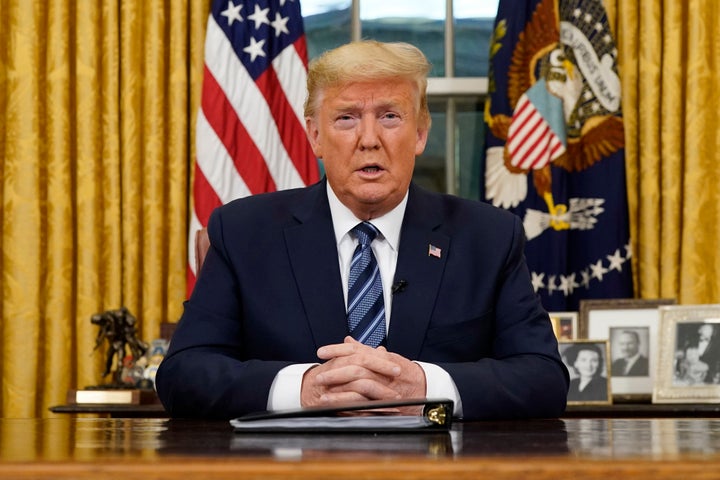During his first address to the nation on the global coronavirus pandemic, President Donald Trump characterized COVID-19 as a “foreign virus” while touting his decision to institute travel restrictions with China and announcing plans to close the U.S. to visitors from most of Europe.
Meanwhile, he has been raked by critics — and the markets — for failing to thoroughly explain how the government plans to address the lack of tests and spiking number of cases across the U.S. His administration has for weeks downplayed the threat of the virus, even as experts warned it is on track to spread exponentially.
Trump clearly sees the novel coronavirus as just another foreign invader to keep out — a viewpoint reflected both in his policy proposals and the way he and his administration talk about the virus. This approach is in line with his overarching political strategy of exploiting Americans’ fears to justify racist, nativist policies.
“This is the most aggressive and comprehensive effort to confront a foreign virus in modern history,” Trump said Wednesday about his administration’s response while blaming the European Union for failing to take steps to prevent contagion. Several European countries have fewer cases of coronavirus per capita than the U.S.
It’s not just Trump. Health and Human Services Secretary Alex Azar repeatedly referred to the disease as the “China coronavirus” during a briefing last month. Anti-immigration zealot Rep. Paul Gosar (R-Ariz.) — who is in self-quarantine after being exposed to coronavirus at the Conservative Political Action Conference in Maryland — has gone out of his way to describe the virus as the “Wuhan virus,” a reference to the location of the first outbreak.
When Gosar’s critics argued that the congressman shouldn’t spread racist stereotypes, Rich Lowry, the editor of the right-wing National Review, wrote an entire column insisting the illness be called the “Wuhan virus.” “China deserves to be connected to the virus that it loosed on the world,” he argued.

Meanwhile, the Department of Homeland Security has sought to use coronavirus as justification for restricting migration at the southern border.
“Large, uncontrolled migrant flows to the U.S. that overwhelm our system and crowd our facilities presently pose a clear and present health risk to Americans,” DHS claimed in an update sent to lawmakers, according to The Wall Street Journal. “We are safer, and better prepared, now for the virus because of all the things the administration has done to secure the border, uphold our laws, and reduce the crisis-level migrant flows of last year,” DHS said, according to BuzzFeed.
The false notion that Mexicans spread diseases to the U.S. was part of the basis for Trump’s racist immigration policy when he first ran for president. In 2015, Trump claimed without evidence that “tremendous infectious disease is pouring across the border” from Mexico. There have been only eight confirmed cases of coronavirus in Mexico, compared to more than 1,300 in the U.S.
And the Trump administration’s policy of forcing asylum-seekers to wait for their court dates in overcrowded and unsanitary camps and shelters near the border in Mexico is putting thousands at risk.
Xenophobic language to describe the outbreak also has consequences for some Asians in the U.S., who have reported abuse including being punched in the face and sprayed with Febreze on the train, as well as having their car vandalized with the phrase, “Fuck Asions [sic] … and coronavirus!”
The president may be hoping that fear-mongering will obscure glaring failures in the federal response to the coronavirus outbreak. On Wednesday, the president continued to insist “the risk is very, very low” for most Americans. But he failed to address the lack of available test kits, and he offered confusing information about the type of relief people could expect.
Trump claimed in his remarks that health insurance companies had agreed to waive copayments and extend coverage for coronavirus treatments — but a spokesperson for the insurance lobby AHIP told Politico the plan was only to waive copayments for testing. Trump also promised to take “emergency action” to provide financial relief to Americans who stay home from work sick — just hours after his own party blocked an effort in the Senate to guarantee workers 14 days of paid sick leave.

